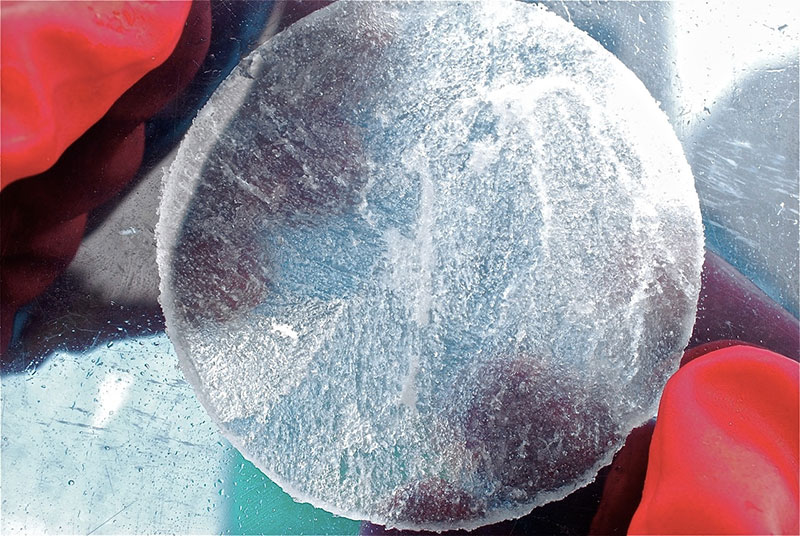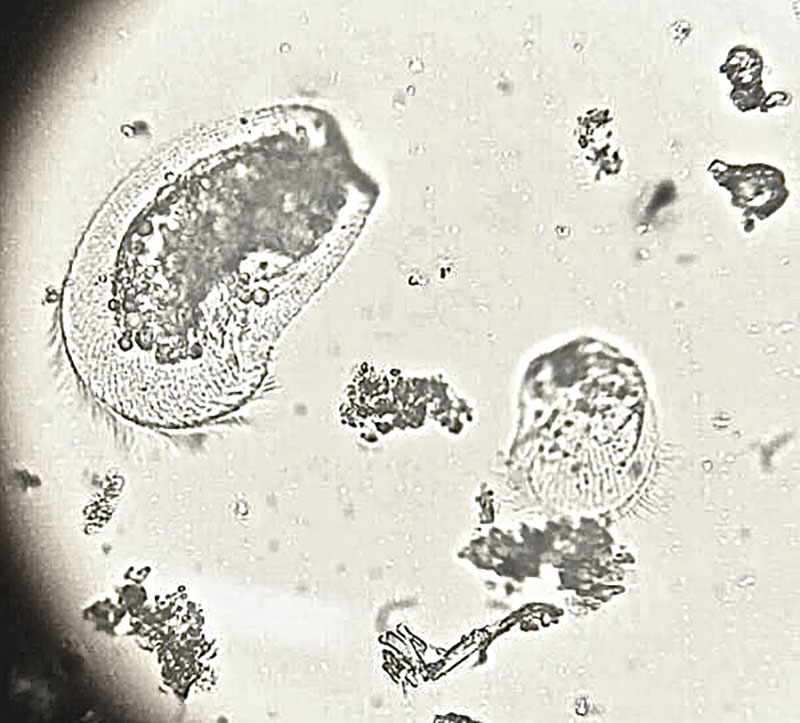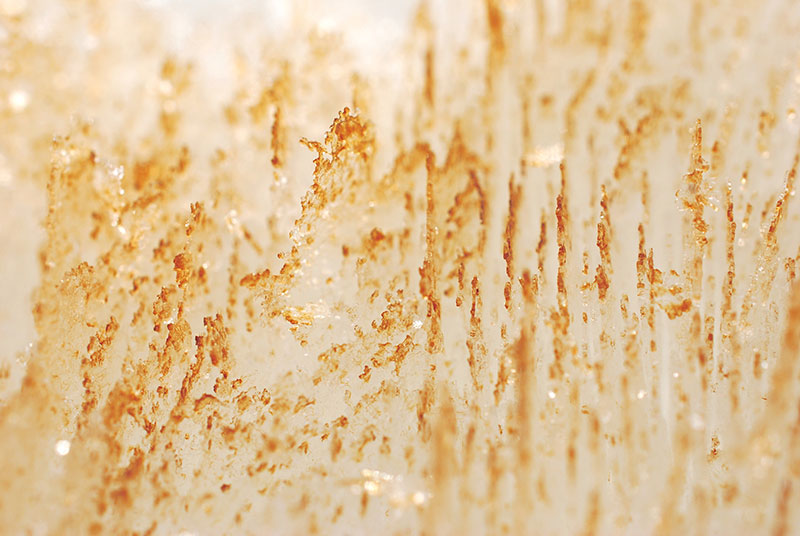
by R. Eric Collins, Assistant Professor of Oceanography, University of Alaska Fairbanks

Eric Collins cuts off the bottom of a sea ice core containing sea ice algae. Image courtesy of Eric Collins, University of Alaska Fairbanks. Download larger version (1.6 MB).
Sea ice is a layer of frozen seawater floating on the surface of the ocean. This icy layer ranges in thickness from a few centimeters to over 10 meters and is present year-round in the Arctic and the Antarctic, though the total extent varies greatly as the seasons change. Within the ice, salts and organisms are trapped in crevices known as brine pores.
During this expedition, we will study the various complex networks that intersect to make up this unique, extreme ecosystem: brine channels, food webs, and genetic exchange networks that are all dominated by microbes.
Presently, the habitable volume of sea ice (~10 percent of its total volume) is roughly equivalent to the volume of all of the rivers on Earth. Ongoing decreases in ice volume due to climate warming lead to a decline in the habitable space for microbes – the primary inhabitants of sea ice. These microbes form highly complex networks that tie together the atmosphere, ice, seawater, and ocean sediments. Due to the logistical difficulties involved in working in the polar regions, these networks have been understudied.
Ice algae are perhaps the most well-known sympagic (ice-associated) microbes, but the rest of the microbial community – Bacteria, Archaea, heterotrophic protists, fungi, and viruses – have not received as much attention. It is important to study the connections among algae, other microbes, and the animals that depend on them to understand how these networks will respond in a warmer future.

This image shows the sea ice microstructure, including ice crystal boundaries. Image courtesy of Eric Collins, University of Alaska Fairbanks. Download larger version (534 KB).
Water has the unusual property that it expands as it freezes – most other compounds behave the opposite. This means that instead of sinking to the bottom of the ocean, frozen seawater floats on the surface where it provides a stable platform for hundreds of species of animals, from polar bears to invisibly small worms. To the polar bear, the ice appears solid, but zoom in to the level of the microscopic worm and you would see that sea ice – unlike freshwater ice – is actually riddled with millions of pores.
The pores are formed when salts are excluded from the growing ice crystals and collect at the ice crystal boundaries. The pores are about 10 times smaller where it is colder (e.g., -20°C) than where it is warmer (e.g., -2°C), and can be very salty.
In the larger, warmer pores live tiny crustaceans called copepods, slithering worms the width of a human hair, and many other algae-eating animals. However, only microbes can live in the smaller pores.
In the spring and summer, a thick layer of single-celled algae often grows within the brine network at the base of the ice, feeding an entire community within and surrounding the ice. As the ice melts in the summer, these algae sink rapidly to the seafloor, where they feed another community of bottom-dwelling organisms.
The ice algae prefer growing at the interface between the sea ice and the seawater because there they can acquire nutrients from the seawater and light filtering down through the ice above. Light is transmitted well through ice, but is blocked by snow, so the snow depth often determines how well the algae grow. In the Arctic summer, there are 24 hours of sunlight, so these algae can grow very quickly until they use up all of the available nutrients.
Bacteria in the brine network act as degraders and recycle nutrients back to the algae. Heterotrophic protists eat the bacteria and algae directly, and are in turn eaten by microscopic animals. Fungi and viruses act as parasites, keeping carbon flowing through the 'microbial loop.'

Light microscope image of sea ice meiofauna. Image courtesy of Eric Collins, University of Alaska Fairbanks. Download image (119 KB).
The microbes in sea ice have had to adapt to extreme conditions in the brine network, where temperatures sometimes drop below -40°C and it can be seven times as salty as the ocean.
Animals, like polar bears and humans, can adapt to extreme conditions slowly by natural selection or behavioral changes, but microbes have another trick up their sleeves, called horizontal gene transfer. This trick, which is used almost universally by Bacteria and Archaea, and sometimes by algae and protists, can be thought of as getting a part from a junkyard instead of inventing it from scratch.
When microbes die, their genetic material (DNA) is released into the environment. Many microbes have the ability to pick up this DNA from the environment and incorporate pieces of it (genes) into their own genomes. If the new genes are beneficial, the microbe's descendants have an edge over their rivals and these genes can become 'fixed' in the population by natural selection. If the genes are harmful or provide no advantage, they are likely to be lost or replaced by another set of genes.
This process of gene exchange is much, much faster than inventing a gene from scratch and is the same process that has led to the rapid proliferation of antibiotic resistance genes in the medical field. Microbes in the Arctic have used horizontal gene transfer to adapt to the low temperatures and high salt conditions, as well as to the presence of environmental contaminants like mercury.

Close up of sea ice algae growing in the skeletal layer of sea ice. Image courtesy of Eric Collins, University of Alaska Fairbanks. Download larger version (2.3 MB).
As we learn to navigate the hidden networks within the Arctic, we find that microbes are central to their functioning, but there is still a lot to explore. Some of the questions we will be asking on the Chukchi Borderlands expedition are:
We look forward to sharing our explorations with you further as the research cruise progresses!